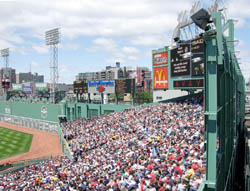Fenway Gets New Sound System

- BOSTON,MA-Boston's Fenway Park is the oldest baseball park in the major leagues. Since 1912, Fenway has seen its share of renovations, with a new sound reinforcement system implemented this past off-season that includes new seating sections built on the grandstand roof and the club level reconfigured and remodeled.
- The distributed sound system was designed by Wrightson, Johnson, Haddon & Williams (WJHW) of Dallas, with installation and custom engineering services provided by Boston Light & Sound. According to WJHW senior consultant, Mark Graham, the distributed system approach was taken to provide solid, full-bandwidth coverage at every seat in the house, replacing the previous point-source cluster design.
The new sound design for Fenway Park includes more than 200 zones of loudspeakers, driven by QSC Audio power amplifiers, that offer coverage to defined seating sections.
Confined within a triangular "block" of the city's Fenway neighborhood, the ballpark presents a lot of complicating anomalies, such as the famed "Green Monster" wall behind left field that reaches a height of almost 40 feet, as well as a general lack of symmetry and seating sections that have evolved organically over the years. This affected both the design and install facets of the project, particularly in terms of loudspeaker mounting and positioning.
The new system includes more than 200 zones of loudspeakers that offer coverage to defined seating sections. All loudspeakers are driven by QSC Audio power amplifiers, rackmounted in two air-conditioned rooms behind the left- and right-field grandstands. One room hosts 56 amplifiers and the other has 48, and with only a couple of exceptions, each amplifier drives two loudspeakers.
QSC CX Series amplifiers with QSC PowerLight 4.0 amps drive the low-frequency needs of the system's larger loudspeakers. "This is what we typically do when using QSC amplifiers on projects of this nature," Graham noted. "The PowerLight Series can really deliver the extra power."
QSControl.net is the crucial backbone tying the entire system together, integrating QSC's amplifier and loudspeaker management, configurable digital signal processing and digital audio transport into a unified system. It starts in the new audio control booth on the grandstand club level, where a QSC BASIS 904zz processor works nine BASIS 904zz and 914lz processors in each amplifier room.
The BASIS processor in the control room assigns the audio to CobraNet bundles, which are then distributed via fiber optics to the BASIS/amplifier packages in the remote equipment rooms. In addition, system control data is routed in the same manner to each location, but on separate fiber-optic runs. Network switches at both ends facilitate the conversion of the data and audio program for fiber transport.
"Fiber optics provide much greater immunity to common problems of longer cabling runs, such as hum and buzz," explained Mark Rowinski of Boston Light & Sound, who took the lead in implementing QSControl.net. "But we also built in analog audio and control lines, so that if there's a problem with the fiber, it can be quickly switched via the control room BASIS unit. There's a seamless transition between the two. You can't hear a difference."
A PC in the control room hosts QSC Venue Manager software that is another essential element of the backbone. It provides monitoring and control of every power amplifier in the system.
The new control room, a late addition to the project that was put together by Boston Light & Sound in about a month's time, is fronted by a Mackie Onyx 1640 16-channel mixing console built into the worksurface at the operator's position, with the sound quality of the board's microphone preamps being a primary factor in its selection.
A daily selection of the top stories for AV integrators, resellers and consultants. Sign up below.
The AVNetwork staff are storytellers focused on the professional audiovisual and technology industry. Their mission is to keep readers up-to-date on the latest AV/IT industry and product news, emerging trends, and inspiring installations.
